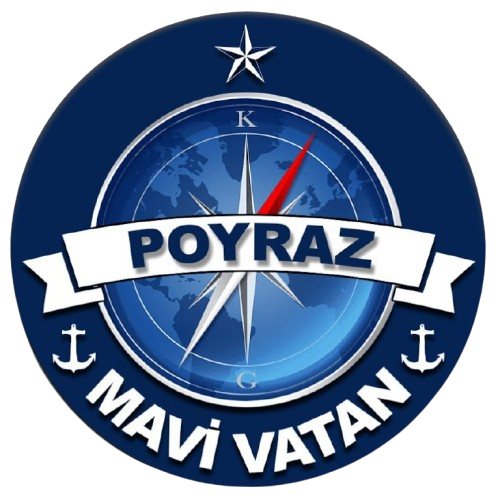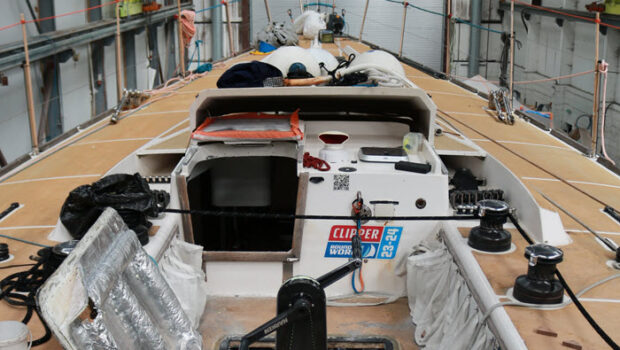The Clipper 70 was introduced for the 2013-14 Clipper Round the World Yacht Race, and is now preparing to carry novice crew for another 40,000 nm lap in 2025-26. Designed by Tony Castro, it will be the sixth edition for the identical 11-boat fleet.
Getting all of them to the finish line is an absolute priority, particularly since the twelfth boat sank after hitting a reef. That’s where the Clipper Race Maintenance Team comes in.
Led by Greg North, Head of Fleet Maintenance, after each edition, his team strips each yacht down to its bare bones and rebuilds it back to race-ready condition, ensuring safety, reliability, and performance for the next crew of adventurers. Each yacht is then independently inspected and signed off by two certifying authorities ahead of the start.
The refit process is a major undertaking, spanning nine months from August 2024 to May 2025. But it’s this meticulous approach from the team that ensures that each Clipper 70 is in its best condition for the next group of race crew who will take the fleet around the world.
This extensive process involves stripping everything out of the yacht, unstepping the mast, hauling it out of the water, and moving it into a boat shed. From there, the team removes the old vinyl wrap, deep-cleans all fabrics, and overhaul or replaces key systems, including electronics, navigation, deck gear, plumbing, engines, generators, watermakers, and steering.
The interiors are repainted, the standing rigging is replaced, and fresh exterior vinyl is applied. Once all these crucial steps are complete, the yacht is returned to the water, the mast is re-stepped and rig tuned, stores are replenished, and just before the race, brand-new sails and running rigging are fitted. After months of hard work, the fleet is once again race-ready and prepared to face the demanding conditions of the Clipper Race.
So, what exactly goes into this massive operation? And how does the team keep the fleet in top condition as it sails around the world?
Greg North provides an inside look at the refit process and the challenges of maintaining a fleet built to conquer the toughest conditions the ocean can throw its way.
Why is a complete refit after each race necessary?
Sailing around the world isn’t easy on the crew or the boats. A full strip-down and rebuild ensures the yachts are structurally sound, safe, and ready for the next race.
How do these refits extend the lifespan of the fleet?
Refitting lets us inspect every component at a nuts-and-bolts level, spotting and fixing areas that need maintenance before they arise. It also gives us the opportunity to upgrade systems with newer, safer, and more efficient equipment. With proper maintenance, a well-built fleet can keep sailing indefinitely.
What are the biggest challenges your team faces during the refit?
Managing time effectively across our fleet is our biggest challenge. Once you strip a boat to barebones, new areas of maintenance tend to appear, but that’s exactly why we do it. We want to ensure each yacht is safe and race ready.
What measures are taken to ensure the yachts are race-ready?
We have a dedicated team of ten full time engineers, each specialising in different areas, with extensive experience across multiple circumnavigations. Every yacht undergoes independent inspections by two certifying authorities – Malta and the UK. This double certification isn’t standard in the marine industry, but given the extreme conditions our fleet faces, we want twice the assurance that they’re ready to take on anything Mother Nature throws at them.
How do you test the boats before they leave for the next race edition?
After the refit, the yachts first go into circulation for Skipper and First Mate sailing, then back into the Clipper Race Training program. Finally, they’re handed over to the Skippers and Mates who will be taking them round the world for Level 4 Training and prep weeks. During this time, the new rigging undergoes multiple test cycles to ensure the fleet is ready to race by the end of summer.
Keeping the Fleet Running During the Race
The refit is just one part of the job. The Maintenance Team also travels to every race stopover, providing essential repairs and servicing to keep the fleet in top condition.
What kind of maintenance does the team perform at stopovers?
Pretty much everything! Our professional Skippers and First Mates, with support from Race Crew, handle the routine upkeep, but our team is there to service critical systems like rigs, engines, watermakers and navigational gear, so the yachts can keep racing at full capacity for the entire circuit.
What are the most common issues you encounter during a race?
It depends on the stage of the race. In light-wind conditions, electrical and generator issues are more common because they work harder in hot, slow conditions. In rougher seas, we see more deck gear and rigging wear from the constant strain, keeping our riggers busy at the next port.
Have you ever had to handle a major repair at a stopover?
Plenty! When we raced the Clipper 68s, we had two dismastings on the same leg, which meant shipping two 90ft masts to Hawaii, stepping them, tuning them, and getting the yachts back into the race.
Then there are the unpredictable ones: rudders snapping after hitting submerged debris, rogue waves flattening helm stations, and even Sydney’s local bird population chewing through masthead wiring, wiping out wind data across the entire fleet.
Behind the Scenes: The People and Logistics
How many people are on the refit and maintenance team?
The core team has ten members, but during refit season, we double that to get everything done in time for the next Race Start.
What does a typical day look like for your team during a stopover?
The day starts with an early team briefing at our maintenance container, prioritising any urgent issues. The team then heads to the boats for repair work while also assisting crew members with their own maintenance tasks. By the evening, we regroup to log progress, and if we’re lucky, someone might even have a cold beer ready for us!
How do you manage logistics for spare parts and repairs across different locations?
We operate two maintenance containers that leapfrog each other around the world, each stocked with essential spare parts. Race Skippers also keep us updated while at sea so we can ship additional parts to upcoming stopovers as needed.
The Passion Behind the Work
What’s one thing people don’t realize about keeping the Clipper Race fleet in top condition?
The sheer scale of logistics involved! It’s not just tools, parts, and time. It’s sourcing bespoke components from manufacturers worldwide while juggling inspections, certifications, and compliance. There’s a lot happening behind the scenes to keep everything running smoothly.
What do you enjoy most about leading this team?
We’re not just colleagues; we’re friends. Everyone on this team has a huge work ethic and a real passion for what we do. They’re the biggest reason I’ve been part of this team for 20 years.
What’s the most rewarding part of preparing the fleet for another race?
Hearing our UK surveyor say that our fleet is in the best shape he’s seen was a proud moment. That kind of recognition reflects the hard work and skill of the entire team, not just maintenance, but also the Race Office and Training Staff.
Event Details: www.clipperroundtheworld.com
About the Clipper Round the World Yacht Race:
The Clipper Race was established in 1996 by Sir Robin Knox-Johnston, the first person to sail solo non-stop around the world in 1968-69. His aim was to allow anyone, regardless of previous sailing experience, the chance to embrace the thrill of ocean racing; it is the only event of its kind for amateur sailors.
Held biennially, the Clipper Round the World Yacht Race has a fleet of eleven identical Tony Castro designed Clipper 70s that compete on a multi-leg course around the world. The team having the best cumulative score over the entire course wins the Clipper Race Trophy. The 2025-26 race will be the 14th edition.
Source: Clipper Round the World Yacht Race
SCUTTLEBUTT News Link !
DemirHindiSG 17 Nisan 2025-20:09







